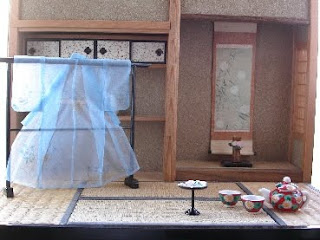Ise-ondo Koi no Netaba(伊勢音頭恋寝刃)
On the 4th day of the 5th month in the lunar calendar (on June 9th in the Gregorian calendar), Nine people were killed or injured by a doctor at a brothel in Huruichi(古市) near Ise Jingu(or Ise Grand Shrine, 伊勢神宮). In two days, he committed suicide at his uncle's house.
Ise-ondo Koi no Netaba(伊勢音頭恋寝刃) was written by Chikamatsu Tokuzou(近松徳三) based on this incident. He added a family feud and investigation of a noted sword to the story. It was premiered as a kabuki play in late summer in 1796.
In kabuki, this play is a regular performance in summer.
It was made into a bunraku play in 1838. In bunraku, some parts of the play are performanced. The bunraku play produces a humorous visual effect by cutting a puppet's head completely in half.
It appeared as the indiscriminate mass killing to me.
The doctor's uncle was a onshi(御師).
Onshi(or oshi) belonged to temples or shrines, showed worshippers around them and arranged accommodations for worshippers like travel agencies.
Onshi belonging to Ise Jingu travelled all over the country and encouraged people to make a pilgrimage to the shrine.
Ise Jingu is the holiest site in Shinto. However, the war-torn era had caused a decrease in both worshippers and onshi's incomes. So they started promotional activities to attract more worshippers in the Edo Period(1603-1868).
Commoners were prohibited from moving freely across Japan in the Edo Period, but only going in pilgrimage was allowed.
They went on a sightseeing trip to Ise and other sacred places such as Todai-ji(東大寺) in Nara Prefecture, Kiyomizu-dera(清水寺) in Kyoto, Kotohiragu(金刀比羅宮) in Kagawa Prefecture, Zenkou-ji(善光寺) in Nagano Prefecture and Kumano-sanzan(熊野三山) in Wakayama Prefecture under color of religious pilgrimage.
In the 1830s, 4.8 million people, which accounted for a sixth part of the total population in Japan, made pilgrimages to Ise Jingu.
The cost of the pilgrimage was comparable with a farmer's annual income, so fellow pilgrims put aside some money on a regular basis for the pilgrimage and chose a delegate as a pilgrim to Ise by lot.
Japan in the Edo Period had good road connections. It was easy to find accommodation along the main roads. Travellers enjoyed local dishes. They were able to send their souvenirs to their houses by parcel delivery service when they went along the Tokaido (東海道) road. It was dangerous to carry large amounts of cash, so they were able to use draft for remittance.
Ise Jingu has two main shrines, Naiku (内宮) and Geku (外宮).
The Inner Shrine, Naiku is dedicated to the worship Amaterasu-omikami(天照大御神, the Goddess of the Sun) who is regarded as an imperial ancestor. The Outer Shrine, Geku is dedicated to Toyouke omikami(豊受大御神), the deity of agriculture and industry. Originally, the deity was enshrined to serve meals to Amaterasu-omikami in Ise Jingu.
First of all, onshi showed farmers around Geku. Farmers are so impressed to see that the deity of agriculture was enshrined in Ise Jingu.
Onshi dressed for welcoming worshippers. They served much-prized delicacies to worshippers with magnificent lacquer multitiered boxes. Although farmers usually used to sleep in pallets, onshi prepared silk futons(bed and comforter) for worshippers.
As an optional extra, onshi held kagura(ceremonial dances of Shintoism) as a dedication to the gods to make a wish to the gods in the onshi's house. Because commoners were prohibited from making personal wishes to the gods at Ise Jingu.
Onshi also took them to the brothels in Huruichi.
According to records, a group of 20 farmers from Sanuki(now Kagawa Prefecture) spent two million yen in five days and a group of 38 people spent more than 10 million yen in a current value.
It is said that farmers didn't feel ripped off. It was a once-in-a-lifetime experience for them, so the Journey must have left them with unforgettable memories that would last a lifetime.
People in groups took pilgrimages to Ise once 60 years. It's called Okage-mairi(お蔭参り). It was said that Okage-mairi started after Ise Jingu's talismans dropped out of the sky.
In the end of the Edo Period, people started to dance saying "Ee ja nai ka(ええじゃないか)" when talismans dropped out of the sky. Some people say the dance was reflected in political uncertainty at the time.
I have heard that "Ee ja nai ka" was similar to the Ghost Dance of 1890 in that people were concerned about what was happening in their coutries.
The profession as onshi was abolished in the Meiji Period.
Recently, Ise Jingu is attracting attention as the place where the people are bestowed with psychic powers. There is no science to it.
Ise-ondo(伊勢音頭) is a local folk song in Ise of Mie Prefecture.
Pilgrims to Ise Jingu brought the song back, so it got around throughout Japan.
「伊勢は津でもつ、津は伊勢でもつ、尾張名古屋は城でもつ」
"Tsu(津) is the mainstay of Ise, Ise is the mainstay of Tsu, Nagoya Castle is the mainstay of Nagoya(名古屋)"
Tsu(津) means main ports in Ise(now Mie Prefecture).





















